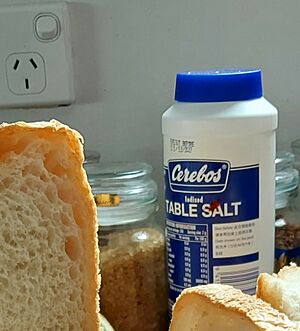Cerebos facts for kids
 |
|
| Subsidiary | |
| Industry | Processed foods |
| Founder | Mawson & Swan |
|
Area served
|
Worldwide |
| Products |
|
| Owner | Kraft Heinz (Asia Pacific) Premier Foods (UK) K+S (Western Europe) Bud Group (South Africa) |
Cerebos is a famous brand known for its salt. Over time, it has also started making other products like food flavorings and nutritional supplements. The Cerebos brand is owned by different companies around the world. For example, Kraft Heinz owns it in Asia Pacific, Australia, and New Zealand. Premier Foods owns it in the UK, and K+S owns it in Western Europe. In South Africa, the Bud Group owns the brand.
The Cerebos salt product was first created by George Weddell, a chemist from Scotland. He worked for a British company called Mawson & Swan. Later, a new partnership, Mawson, Swan & Weddell, began selling the salt under the Cerebos name.
Contents
The Story of Cerebos Salt
The company Cerebos Ltd was officially started in 1894. Back then, salt was usually sold in big blocks. People had to scrape off the amount they needed to use. Cerebos introduced something new: salt that flowed freely from the container.
Why Free-Running Salt Was Special
Pure salt, or sodium chloride, tends to absorb moisture from the air. This makes the salt crystals stick together, a problem called caking. Cerebos salt was special because it contained ingredients that stopped it from caking. This meant the salt would always pour easily.
The company's slogan was "See How It Runs". This slogan highlighted how easily their salt poured. The product's packaging also featured a small boy chasing a chicken. He was shown pouring salt onto its tail. This image was a fun reference to an old belief that you could catch a bird by putting salt on its tail.
Cerebos and Explorers
Cerebos salt was even taken on an amazing adventure! Ernest Shackleton, a famous explorer, listed Cerebos salt among the few important supplies he took. He carried it on his dangerous journey with five men from Elephant Island to South Georgia. This was part of his brave attempt to escape the Antarctic.
Cerebos Factories and Changes
From 1923 until the middle of the 1900s, Cerebos Ltd had a factory in North Acton, which is in northwest London, UK. In 1968, a company called Rank Hovis McDougall (RHM) bought Cerebos. The old factory site was later turned into a housing area in the mid-1990s.
Where Cerebos Products Are Sold
Cerebos salt is sold in many places around the world. This includes Western Europe, like France (where it's spelled Cérébos), Australia, New Zealand, and South Africa.
Cerebos in Australia and New Zealand
The Cerebos operations in Australia and New Zealand were once part of Cerebos Pacific. Now, they are owned by Kraft Heinz. Kraft Heinz bought most of these businesses from Suntory Holdings in 2018. These operations include many well-known local brands:
- Greggs (NZ)
- Robert Harris (NZ)
- Bisto (NZ)
- Raro (NZ)
- atomic (NZ)
- Whitlock's (NZ)
- L'affare (NZ)
- Bruno Rossi (NZ)
- Gravox (Australia)
- Fountain (Australia)
- Toby Estate (Australia)
- Saxa (Australia)
- Foster Clark's (Australia)
- Mocopan (Australia)
- Asian Home Gourmet (Australia)
Brand Identity
The image of a boy chasing a chicken and pouring salt on it has become a very recognizable symbol for the Cerebos brand. It's an icon that many people connect with the company.
Bisto Gravy Powder
The Cerebos salt company actually created the popular 'Bisto' gravy powder. This product is a mix of salt, flavorings, and colorings. It was invented at Cerebos's salt factory in Middlewich, Cheshire, in the United Kingdom.
Bisto was later acquired by RHM in 1968. RHM then sold its shares in Cerebos South Africa in the 1980s. In 1990, RHM sold Cerebos Pacific to Suntory.
External Links
- Cerebos France on esco
- Cerebos South Africa
- Documents and clippings about Cerebos in the 20th Century Press Archives of the ZBW


